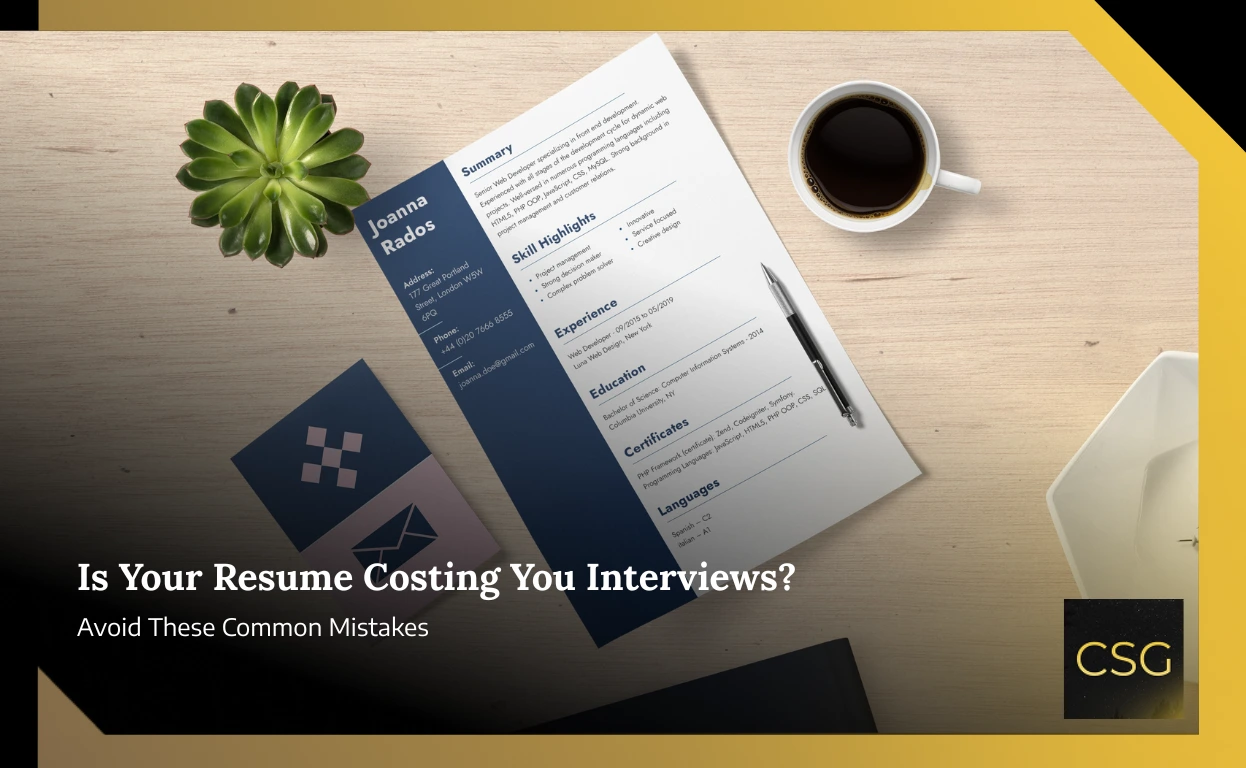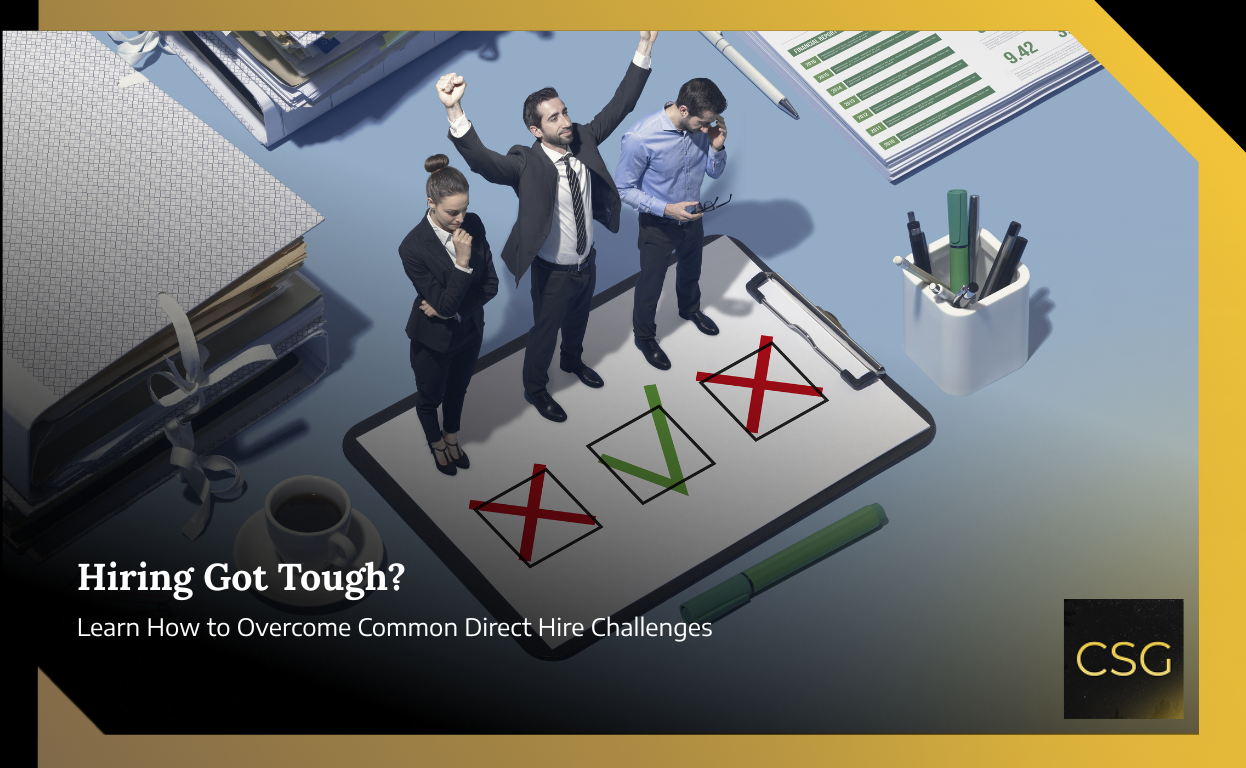Your resume is more than a summary of your work history; it’s your first impression and often your only chance to stand out in a crowded job market. Research shows that recruiters spend just 7.4 seconds scanning a resume before making a decision. That means every detail counts.
In fast-paced industries like healthcare, logistics, technology, and manufacturing, where employers need to fill roles quickly and accurately, even minor mistakes can lead to major missed opportunities. Adding to the challenge, many resumes are screened by Applicant Tracking Systems (ATS) that filter out documents with poor formatting, missing keywords, or unclear structure often before a real person reviews them.
If you’ve been sending out applications but hearing crickets, the issue might not be your qualifications, it might be how you’re presenting them. The good news? Most resume mistakes are fixable, and correcting them could be the key to landing your next role.
Summary
- Common resume mistakes such as typos, poor formatting, outdated objectives, irrelevant experience, and lack of tailoring often prevent candidates from passing ATS filters and catching recruiters’ attention.
- The most damaging errors include listing duties instead of achievements, missing industry keywords, using unprofessional contact details, or making resumes too long or too short.
- Fixes involve proofreading, clean formatting, tailoring each resume to the job description, showcasing measurable results, and ensuring ATS-friendly structure.
- By avoiding these pitfalls and presenting experience strategically, job seekers can improve visibility, secure more interviews, and stand out in a competitive market.
Top 10 Resume Mistakes Job Seekers Should Avoid
Crafting a great resume isn’t just about listing your experience, it’s about presenting it in a way that’s polished, strategic, and aligned with what employers (and their software) are looking for. Let’s break down the most common resume mistakes and how to fix each one effectively.
1. Typos and Grammatical Errors
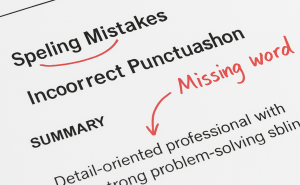
Even a minor spelling or grammar error can cost you an opportunity. In fields where precision is vital like healthcare or IT a typo such as “manger” instead of “manager” may signal carelessness to recruiters.
Why it’s a problem: Hiring managers review dozens, if not hundreds, of resumes. A typo can signal a lack of attention to detail, which is especially concerning for roles involving patient care, safety compliance, technical documentation, or inventory accuracy.
Fix it:
- Don’t rely solely on your eyes. Run your resume through tools like Grammarly, Hemingway Editor, or Microsoft Word’s spell check.
- Read it aloud to catch awkward phrasing or repeated words.
- Ask a friend or mentor to proofread it’s easy to miss your own mistakes.
2. Poor Formatting and Layout Issues
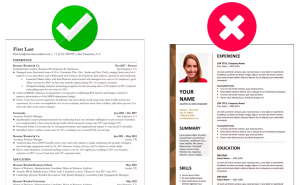
If your resume looks cluttered or inconsistent, recruiters won’t bother trying to decode it. This includes inconsistent font sizes, cramped margins, unclear section breaks, or using design elements that confuse ATS (Applicant Tracking Systems).
Why it’s a problem: ATS software and hiring managers need to scan resumes quickly. A poorly formatted resume can prevent your skills from being seen—even if you’re highly qualified.
Fix it:
- Use professional, clean fonts such as Arial, Calibri, or Times New Roman in sizes 10–12.
- Stick to single-column layouts with clear section headers: “Summary,” “Work Experience,” “Skills,” etc.
- Avoid using graphics, text boxes, or tables they can break when parsed by ATS software.
- Ensure spacing is even, margins are consistent, and bullet points are aligned.
3. Outdated Resume Objective
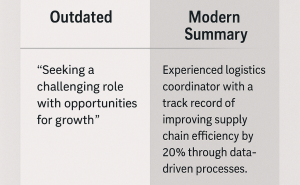
Generic objectives like “seeking a challenging role with opportunities for growth” are no longer effective. They don’t provide value or explain how you fit the job.
Why it’s a problem: Hiring managers care more about what you can offer them than what you hope to gain from the job. A vague objective wastes space that could be used to demonstrate value.
Fix it:
- Replace with a concise professional summary that showcases your qualifications, experience, and goals relevant to the role.
- Tailor it to the industry. For example:
“Experienced logistics coordinator with a track record of improving supply chain efficiency by 20% through data-driven processes.”
4. Lack of Tailoring to the Job Description
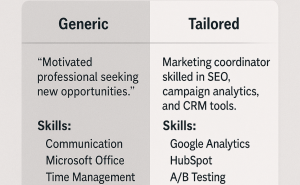
A single, generic resume for every application might feel efficient—but it often results in being overlooked. Employers want to see how your skills align with their specific needs.
Why it’s a problem: Recruiters can quickly tell if your resume is a copy-paste effort. Lack of personalization suggests lack of interest or effort—and that hurts your chances.
Fix it:
- Analyze the job posting and identify key skills, tools, and qualifications mentioned.
- Reflect those keywords naturally throughout your resume, especially in your summary, skills, and work experience sections.
- Highlight projects or achievements that directly relate to the job you’re applying for.
5. Including Irrelevant Experience
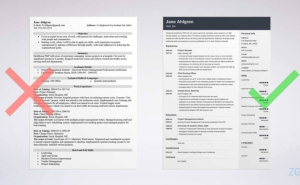
Listing every job you’ve had since high school might seem thorough but it actually distracts from your most relevant qualifications.
Why it’s a problem: Hiring managers don’t have time to sift through unrelated roles. Irrelevant details can dilute your core message and make your resume feel unfocused.
Fix it:
- Prioritize roles and experiences that are most relevant to your current goals.
- If you’re switching industries, highlight transferable skills—like leadership, problem-solving, or technical proficiencies.
- For older roles, consider summarizing them in a single line or removing them altogether, especially if they don’t add value.
6. Ignoring ATS Optimization
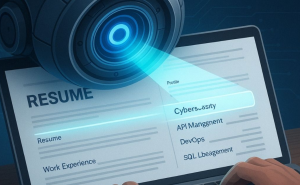
More than 90% of Fortune 500 companies use Applicant Tracking Systems (ATS) to screen resumes. If yours isn’t optimized, it may never reach human eyes.
Why it’s a problem: ATS software scans for specific formats, keywords, and standard section titles. If your resume includes images, custom headings, or unusual formatting, it may not be read correctly.
Fix it:
- Use standard section headings: “Work Experience,” “Education,” “Skills,” etc.
- Avoid graphics, tables, and columns.
- Use relevant keywords and industry terms found in the job description (e.g., “Lean Manufacturing,” “HIPAA compliance,” “AWS”).
- Save your resume as a .docx or PDF—whichever the job listing prefers.
7. Unprofessional Email Addresses
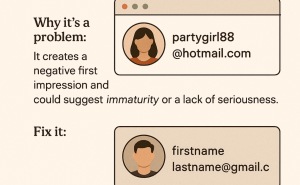
Your contact information is the first thing recruiters see. An unprofessional email address like [email protected] can damage your credibility immediately.
Why it’s a problem: It creates a negative first impression and could suggest immaturity or a lack of seriousness.
Fix it:
- Use a professional address like f[email protected] or a variation if your name is common.
- Also ensure your LinkedIn profile is up to date and aligns with your resume.
Check your voicemail greeting—it should be clear, polite, and professional.
8. Listing Job Duties Instead of Achievements
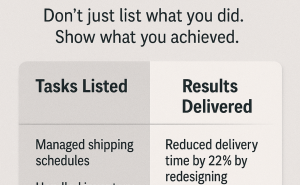
It’s common to list job responsibilities, but that alone doesn’t show the impact you made. Employers want to see results.
Why it’s a problem: A long list of tasks can make your resume feel generic and doesn’t demonstrate value.
Fix it:
- Focus on quantifiable achievements that show how you improved processes, saved time or money, or added value.
- Use action verbs: “led,” “developed,” “streamlined,” “increased,” etc.
- Example:
“Reduced average delivery time by 22% by redesigning warehouse workflow” is more impressive than “Managed shipping schedules.”
9. Too Long or Too Short Resumes
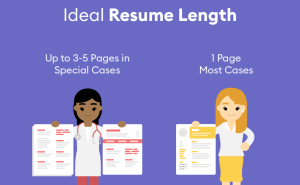
Too short, and you may leave out essential qualifications. Too long, and you risk losing the recruiter’s attention.
Why it’s a problem: A resume that’s not the right length signals either lack of experience or inability to prioritize information.
Fix it:
- 0–5 years of experience: Aim for one page.
- 5–10+ years of experience: Go up to two pages if needed—but be selective.
Focus on quality over quantity. Remove outdated roles, internships, or skills no longer relevant to your current career direction.
10. Missing Keywords and Industry Terms
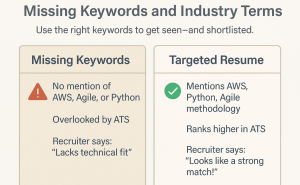
If your resume doesn’t reflect the right tools, certifications, or terminology, you may be invisible to both the ATS and the hiring manager.
Why it’s a problem: Recruiters look for specific tools, platforms, or frameworks relevant to the job. Without those, your resume may seem less qualified—even if you are.
Fix it:
- Research 3–5 job postings for the roles you want. Highlight recurring phrases, software tools, or certifications.
- Integrate those naturally into your resume. Examples:
- Healthcare: “ICD-10,” “EHR systems,” “HIPAA compliance”
- Tech: “Python,” “AWS,” “Agile methodology”
- Manufacturing: “CNC machinery,” “lean six sigma,” “preventive maintenance”
- Tailoring your resume with the right industry language improves both ATS visibility and recruiter interest.
How to Fix Resume Mistakes Effectively
Knowing what to fix is one thing, knowing how to fix it can make all the difference. Whether you’re just starting your job search or revisiting your resume after months of silence, this step-by-step checklist will help you present your experience with confidence.
Step-by-Step Resume Fix Checklist
Use this quick guide to ensure your resume checks all the right boxes:
- Proofread, then proofread again: Use tools like Grammarly or Hemingway Editor, and always have someone else review it for clarity and errors.
- Tailor your resume for each job: Generic resumes don’t perform well. Mirror keywords and language from each job posting to show you’re a strong match.
- Use active voice and action verbs: Replace weak language like “responsible for” with powerful verbs such as managed, led, developed, or streamlined.
- Quantify your achievements: Whenever possible, include measurable results (e.g., “Reduced processing time by 30%” or “Managed a team of 12”).
Ensure ATS compatibility: Avoid graphics, tables, or unusual formatting. Tools like Jobscan can help assess how well your resume aligns with ATS filters.
When to Seek Professional Help
Fixing a resume isn’t always straightforward especially when you’re changing industries, re-entering the workforce, or applying to competitive roles. In these cases, expert help can be a game-changer.
Certified resume writers and industry-focused staffing agencies know what hiring managers are looking for and how to position your experience accordingly.
Learn more about our Staffing Services at Constellation Search. Whether you need a fresh resume or a clear path to your next role, we’re here to help you put your best foot forward.
Real-World Resume Mistakes and Fixes – Case Studies
Sometimes the best way to learn is by example. Here are two real-world scenarios where job seekers transformed their resumes and dramatically improved their job prospects.
Case Study 1: Logistics Coordinator
The Problem:
A mid-level logistics professional had been applying for supply chain roles using a generic resume that simply listed job duties without quantifiable results or relevant keywords.
The Fix:
We helped them reframe their experience with action-oriented language and metrics that showcased impact, such as: “Reduced freight costs by 12% through route optimization and carrier negotiation.”
Each role was also tailored to match the responsibilities and language of the job postings.
The Result:
Within just two weeks, they received four interview calls, including from a nationally recognized logistics firm.
Case Study 2: Tech Job Seeker
The Problem:
A software developer with three years of experience was using a visually attractive resume with columns, charts, and icons—but it wasn’t getting past Applicant Tracking Systems (ATS).
The Fix:
We replaced the graphic-heavy layout with an ATS-friendly format, rewrote their summary using high-value technical keywords like “ReactJS,” “AWS,” and “Agile,” and emphasized project-based achievements.
The Result:
The revised resume led to an interview within 10 days—and a shortlist for a role at a Fortune 500 tech company.
Final Resume Improvement Tips That Make a Difference
Before you hit “submit” on your next job application, take a few moments to review your resume with fresh eyes. These final tweaks might seem small, but they can significantly boost your chances of passing through both Applicant Tracking Systems (ATS) and human reviewers.
Here’s a quick checklist to fine-tune your resume for maximum impact:
1. Break Up Text with Bullet Points
Long paragraphs are hard to scan—especially when recruiters spend just seconds on each resume.
Tip: Use bullet points to highlight accomplishments, key responsibilities, and measurable outcomes. Aim for three to five concise bullets per role to keep your content digestible and scannable.
2. Mirror the Language of the Job Description
Hiring systems and recruiters are looking for alignment. Using different terminology—even if you’re describing the same skill—can make you appear less qualified.
Tip: Incorporate the exact words and phrases used in the job posting, especially in your skills, summary, and work experience sections. This improves your visibility in ATS filters and shows the hiring team you’re a strong match.
3. Align Your LinkedIn Profile with Your Resume
Many recruiters cross-check your resume with your LinkedIn profile. Inconsistencies can raise red flags or create confusion.
Tip: Ensure your job titles, dates, skills, and key accomplishments match across both platforms. Also, include similar keywords to improve visibility in recruiter searches.
4. Pro Tip: Set Aside 30 Minutes for a Focused Resume Review
Don’t underestimate the power of a final polish. Spending just 30 minutes implementing these improvements can be the difference between being passed over and getting that interview callback.
Ask yourself:
- Is every word necessary and impactful?
- Does my resume reflect my most relevant experience?
- Would I be impressed if I were the hiring manager?
Remember: Your resume is more than just a summary of your work history—it’s your professional story, told in a way that gets you noticed. With a little extra attention, you can make it stand out in even the most competitive job markets.
Frequently Asked Questions
Q. What are the most common resume mistakes to avoid?
Typos, poor formatting, lack of tailoring, and missing keywords are among the top mistakes. Other pitfalls include using vague job descriptions instead of measurable results, listing outdated or irrelevant skills, and including too much personal information. Even small errors can make a negative impression, so proofreading and tailoring for each role are essential.
Q. How can I make my resume stand out from others?
Showcase achievements and results rather than just responsibilities. Tailor your resume to each job description by aligning your skills and experiences with the employer’s requirements. Clean, consistent formatting improves readability, while strong action verbs and quantifiable results help demonstrate impact. Remember, recruiters often scan resumes in seconds—clarity and relevance are key.
Q. Do templates hurt or help your resume?
Templates can help by organizing content professionally, as long as they’re ATS-friendly (avoiding columns, graphics, and overly complex designs). A good template ensures consistency in spacing, fonts, and structure, making your resume easy to scan. However, overly stylized templates may confuse applicant tracking systems, so simplicity is best. If you use one, always customize it to your personal brand.
Q. Should I include all my job history?
No. Focus on the last 10–15 years of work experience, emphasizing roles that align with your current career goals. Older or unrelated positions can be summarized briefly or omitted altogether. This keeps your resume concise, relevant, and focused on the experience that matters most to potential employers.
Q. Is a one-page resume still standard?
For new graduates or early-career professionals, one page is ideal. However, for mid-level or senior professionals, a two-page resume is perfectly acceptable if the extra space adds value. The key is to avoid fluff—every line should showcase relevant skills, results, or experience. Employers care more about clarity and impact than strict page limits.
Conclusion – Turn Resume Mistakes Into Job-Winning Fixes
In today’s competitive job market, your resume isn’t just a summary of your experience—it’s your personal pitch to employers. Avoiding common resume mistakes and making smart, strategic updates can mean the difference between being overlooked and getting invited to interview.
If you’re still unsure whether your resume is truly job-ready, don’t go it alone. Let the experts at Constellation Search help you take the next step with confidence. Whether you need professional resume guidance or full-service staffing support tailored to industries like healthcare, logistics, tech, or manufacturing we’re here to help you stand out and succeed.

